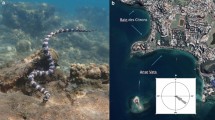Abstract
Intraspecific variation in habitat preference was studied in the black turban snail Tegula funebralis (Adams, 1854), at two locations on the northern U.S. Pacific Coast. Studies in 1977 using a mass-marking technique showed that most snails found either above or in permanent tidepools at low tide return to their original habitats within a few days after experimental habitat reversal. This return is not due to homing behavior, but is apparently based on the recognition of ecological characteristics of the two habitats. Experiments in 1978 with individually-marked snails suggest that they prefer specific intertidal levels, and not merely above-pool or in-pool habitats. Theoretical models predict that this behavior could play a major role in the maintenance of genetic polymorphism in a species like T. funebralis, whose intertidal environment is characterized by extreme spatial heterogeneity.
Similar content being viewed by others
Literature Cited
Byers, B. A.: The ecological behavioral genetics of habitat selection in an intertidal snail, Tegula funebralis, xvi+200 pp. Ph. D. thesis, University of Colorado, Boulder, Colorado 1980
Cavener, D.: Preference for ethanol in Drosophila melanogaster associated with the alcohol dehydrogenase polymorphism. Behav. Genet. 9, 359–365 (1979)
De Souza, H. M. L., A. B. Da Cunha and E. P. Dos Santos: Adaptive polymorphism of behavior evolved in laboratory populations of Drosophila willistoni. Am. Nat. 104, 175–189 (1970)
Fawcett, M. H.: The consequences of latitudinal variation in predation for some marine intertidal herbivores, 156 pp. Ph. D. thesis, University of California, Santa Barbara 1979
Frank, P. W.: On home range of limpets. Am. Nat. 98, 99–104 (1964)
Frank, P. W.: Latitudinal variation in the life history features of the black turban snail Tegula funebralis (Prosobranchia: Trochidae). Mar. Biol. 31, 181–192 (1975)
Giesel, J. T.: On the maintenance of a shell pattern and behavior polymorphism in Acmaea digitalis, a limpet. Evolution, Lawrence, Kansas 24, 98–119 (1970)
Hedrick, P. W., M. E. Ginevan and E. P. Ewing: Genetic polymorphism in heterogeneous environments. A. Rev. Ecol. Syst. 7, 1–32 (1976)
Hewatt, W. G.: Observations on the homing limpet, Acmaea scabra Gould. Am. Midl. Nat. 24, 205–208 (1940)
Kettlewell, H. B. D.: Recognition of appropriate backgrounds by the pale and black phases of Lepidoptera. Nature, Lond. 175, 943–944 (1955)
Levene, H.: Genetic equilibrium when more than one niche is available. Am. Nat. 87, 331–333 (1953)
Maynard Smith, J.: Sympatric speciation. Am. Nat. 100, 637–650 (1966)
Newell, G. E.: The behavior of Littorina littorea (L.) under natural conditions and its relation to position on the shore. J. mar. biol. Ass. U.K. 37, 229–239 (1958)
Paine, R. T.: The Pisaster-Tegula interaction: prey patches, predator food preference, and intertidal community structure. Ecology 50, 950–961 (1969)
Powell, J. R. and C. E. Taylor: Genetic variation in ecologically diverse environments. Am. Scient. 67, 590–596 (1979)
Ricketts, E. F. and J. Calvin: Between Pacific tides, 4th ed. xiv+614 pp (Revised by J. W. Hedgepeth.) Stanford, California: Stanford University Press 1968
Sargent, T. D.: Background selections of geometrid and noctuid moths. Science, N.Y. 154, 1674–1675 (1966)
Sedlmair, H.: Verhaltens-, Resistenz-, und Gehäuseunterschiede bei den polymorphen Bänderschnecken Cepaea hortensis (Müll.) und Cepaea nemoralis (L.). Biol. Zbl. 75, 281–313 (1956)
Silcock, M. and P. A. Parsons: Temperature preference differences between strains of Mus musculus, associated variables and ecological implications. Oecologia 12, 147–160 (1973)
Sokal, R. R. and F. J. Rohlf: Biometry. The principles and practice of statistics in biological research, 776 pp. San Francisco: W. H. Freeman & Co. 1969
Taylor, C. E.: Genetic loads in heterogeneous environments. Genetics, Austin, Tex. 80, 621–635 (1975)
Taylor, C. E. and J. R. Powell: Habitat choice in natural populations of Drosophila. Oecologia 37, 69–75 (1978)
Trpis, M. and W. Hausermann: Demonstration of differential domesticity of Aedes aegypti (L.) (Diptera, Culicidae) in Africa by mark-release-recapture. Bull. ent. Res. 65, 199–208 (1975)
Wara, W. M. and B. B. Wright: The distribution and movement of Tegula funebralis in the intertidal region of Monterey Bay, California. Veliger 6 (Suppl.), 30–37 (1964)
Wecker, S. C.: The role of early experience in habitat selection by the prairie deer mouse, P. maniculatus bairdii. Ecol. Monogr. 33, 307–325 (1963)
Author information
Authors and Affiliations
Additional information
Communicated by N.D. Holland, La Jolla
Rights and permissions
About this article
Cite this article
Byers, B.A., Mitton, J.B. Habitat choice in the intertidal snail Tegula funebralis . Mar. Biol. 65, 149–154 (1981). https://doi.org/10.1007/BF00397079
Accepted:
Issue Date:
DOI: https://doi.org/10.1007/BF00397079




